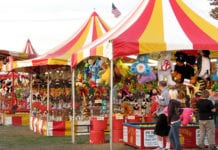- “Good composition is like a suspension bridge—each line adds strength and takes none away.” Robert Henri
——————
Smiling, I said, “So, I’ll see you about 10:00, like you’re so worried about me coming into your classroom. No problem with job security…ha, ha, ha!”
I could see the red splotches begin to form on the ‘teacher of the year’s’ neck. Looking more closely, I asked, “Hey, you’re not really worried about me coming to observe, are you? It’s just a formality, you know? Remember, you are teacher of the year…glowing reviews…”
I kept trying to find a point of connection and interject a little humor.
But she was genuinely nervous. I made a big ‘note to self’ that day: teachers dislike being observed and evaluated – even the best ones.
WHAT AM I LOOKING FOR IN TEACHERS?
In my nearly 40 years of serving as an administrator, mentoring student teachers, and as a school consultant, I have observed hundreds of teachers. And yes, some have gotten some ‘less than stellar reviews’. Likewise, I have worked with many excellent teachers.
The evaluation form may include a number of factors, but I am looking for three key qualities.
1) Is the teacher in charge? Are they cultivating the classroom climate they want?
2) Do they genuinely care about the students? Do the students feel, know, and trust in this unconditional love?
3) Is the teacher creating bridges to reach and teach each learner? Is the teacher actively seeking to vary their teaching style in order to reach all learning styles?
A ROSE BY ANY OTHER NAME IS STILL A ROSE
Obviously, a lot can be said about each point.
Our topic for today is #3: the value of incorporating learning styles into the curriculum and teaching.
Back in my special education days, we individualized for each student. For years, I trained teachers on learning styles and how to build bridges to each learner.
Now it is known as helping differentiate in the classroom. The common denominators are similar. Strong teachers have intuitively understood this for years regardless of what it is called.
Those are the teachers I have hired over the years.
WHAT DOES THIS LOOK LIKE IN THE CLASSROOM?
Let’s start with what it does not look like. It does not mean having everyone on page 87 at 10:32 a.m. perfectly according to plan.
A great teacher’s classroom is something so powerful, so palpable, that you know you are in one the minute you set foot in the door. There is an atmosphere of love, a climate of control, and a unique style of learning that separate it from the ordinary.
What creates your teaching style? These major factors combine to create texture to your teaching and together create a pattern:
- How you perceive information
- How you process that information
- How you personalize that information
- How you pass it along to your students.
For example, if you perceive information on the visual track, process it in your brain visually, you tend to personalize it visually as you pass it along to your students with visual teaching systems and comments such as, “I see what you mean.”
You may be naturally inclined to teach with visual aids, have your students read, write, create a PowerPoint, outline, design, and mind-map, and use other related visual activities. It is your comfort zone.
Subconsciously, you assume that if these techniques help you to learn, it will work for your students as well.
As a bridge-building teacher who is seeking to reach and teach to all learners, I look for teachers that can “speak” the learning language of different learners, such as those who are more auditory, tactile, and kinesthetic.
Or let’s take it a step further. Is a student a more analytic (linear, step-by-step) or a global (big picture) learner?
A veteran teacher teaches to the multiple layers of learning by presenting the material in this fashion:
“This is the big picture of what this concept is about (global), and now, here are the component parts (analytic) that we will be studying.”
“This is what it looks like (visual), and as I explain it to you, I will let you verbally interact with the material (auditory) and tangibly work with it in a hands-on manner (tactile-kinesthetic).”
“Some of you prefer to learn from your text or lab manual (concrete sequential), and I will provide those opportunities. If you prefer to work alone, I can set up your assignments with you (abstract sequential). I can tell by the look on some of your faces that you only want to work with a partner or in small groups (abstract random), while others think ‘outside the box’ and need to create a project to ‘get it’ (concrete random).”
If you are reading this and it seems like a bunch of gibberish, I understand. I am using terms that may not be familiar to you and reducing master teaching to the simplest of terms to illustrate a point.
When I train teachers, I create a form for them that actually does follow that formula – without being too formulaic.
At first, the teacher may seem robotic, but in a short while, it becomes almost like a professional athlete, musician, or ballerina. The whole is greater than the sum of its parts.
In my upcoming February newsletter, which you can sign up for on my Web site, you will find that ‘form.’
If this is new for you, try it out. If the terms are new for you, stick with me for a while, and if I may be so bold, try reading my books. Watch for some videos that are coming to illustrate these teaching techniques as well.
If you have me come out to your school to speak or do a teacher training, I can train your teachers in this technique.
I call it the ‘treasured teaching technique.’ It works. I have seen it succeed in schools, grades Pre-K to grade 12 and in all subjects.
Treasured teachers reach beyond their comfort zone to maximize the learning experience for each kind of learner.
——————-
This blog originally appeared on Jody’s Web site for teachers www.equippingeducators.com where you can subscribe to the blog by e-mail.










